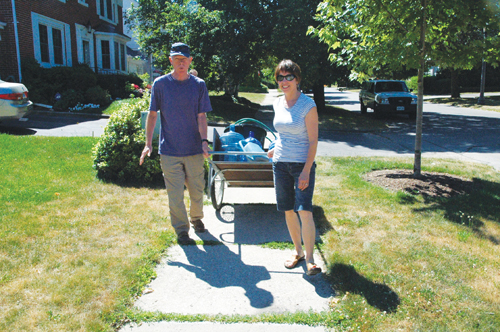

A new paradigm is needed: Kitchener’s urban forest in crisis
Volunteer Tree Stewards Judy and Dan Garrett, members of the Westmount Neigbhourhood Association, help with watering newly planted boulevard trees in their neighbourhood last summer.
Photo courtesy of City of Kitchener
Photo courtesy of City of Kitchener
For News Tips & Advertising call...
Kitchener East - 519-578-8228
Kitchener West - 519-741-5892
 By Carrie Debrone
By Carrie DebroneKitchener Citizen
Just like other resources in the city – roads, community centers, parks and sidewalks - the city’s trees need attention and good management.
The trouble is they have not been getting it. And now, according to Dave Schmitt, the city’s Environmental and Urban Forestry Project Manager, Kitchener’s urban forest is in crisis.
“We need to think about doing things properly and move from a department that reacts to customer complaints to a proactive model,” he said, especially considering the hugely beneficial economic, environmental and social services that our urban forest provides, and the community support it receives.
“Forestry needs to be recognized as a city asset. Other assets decline over the years, but the value of trees increases. You get the most benefit from mature
trees. That’s the reason we need to look 50 to 70
years down the road when planning and maintaining
the urban forest. We need to make our urban forest
sustainable,” Schmitt said.
Schmitt estimates the city has about 45,000 trees on its streets and another 9,000 in its parks. A city report shows Kitchener has a tree canopy of about 22 per cent, low when compared with other cities of similar size in Ontario who Schmitt said are aiming for a canopy of about 40 per cent.
Trees offer many benefits including improving air quality, mitigating climate change through carbon storage, conserving energy by providing shade for buildings and blocking winter wind, and reducing storm water runoff and erosion.
With the city budget talks continuing and the final budget being considered on January 19, Schmitt is hoping his department’s recent report will be considered.
The report urges councillors to think about shifting the current paradigm where the city’s forestry department operates in crisis mode, springing into action in response to calls from the public about dead trees or requests for pruning of low limbs, to a new way of managing the urban forest where funding for it is considered an equal part of the bundle of all other city priorities.
Kitchener’s total urban forestry budget is currently about $1.5 million including operating capital budgets.
“Decisions made from the old paradigm where trees only provide aesthetic beauty and take care of themselves, will always place requests for the urban forest below other priorities,” it states.
If we don’t change this, Schmitt said he believes the city should stop acquiring new natural areas and quit all tree planting.
And the pressure to better manage our urban forest is mounting with the arrival of the Emerald Ash Borer.
First detected locally in August 2010, the Emerald Ash Borer (EAB), a quarantined tree pest, has been confirmed in west and south Kitchener. With the exception of Mountain Ash, the destructive insect kills all ash trees it infests.
Based on current knowledge, it is expected that the EAB will infest the city within five years and that all ash trees will be dead or dying within 10 years.
This will significantly impact the city’s existing tree canopy and the estimated financial cost to the city to remove and replant will be more than $10-million.
There are currently 4,500 ash trees on city street boulevards and the distribution of them varies across the city.
The impact that the EAB will have on other city areas such as active parkland, where about 14 per cent of trees are ash, on natural areas, golf courses and on private lands is not yet known.
In March 2011 the city began a program to determine the extent of the EAB, placing 30 fluorescent green insect traps in ash trees growing in residential areas that have a high ash-tree density.
Parts of the city will also be facing the loss of mature trees as about 60 per cent of Kitchener’s street trees are Norway Maples that are coming to the end of their useful lifespan.
The city is currently completing a tree inventory, compiling the information by wards and Schmitt said the data should be ready soon.
In 2012, Kitchener will also be completing an iTree Eco study that uses a scientific model developed by the United States Forest Service to determine the replacement value of the urban forest. The same model used for an iTree Eco study completed in London pinned that city’s tree replacement value at $1.5-billion, at $878 million for Oakville and at $7 billion for Toronto.
Schmitt said the city will need to educate homeowners and volunteers to care for the young trees planted to replace the new ones the city will plant, adding that there are many myths associated with trees -- three being that tree planting is easy, that once planted trees take care of themselves, and that natural areas also take care of themselves.
The city already has a good start on education. As part of its stewardship and education programming, the forestry department held 46 events in 2011 that attracted 1996 people. They included stewardshiprestoration projects, public hikes, education and outreach, special events, ecological monitoring and the yellow fish road program.
Last year, because of public demand, the city’s forestry operations department also conducted a pilot project with the help of the Westmount Neighbourhood Association tree steward team which mobilized neighbours to assist city officials in watering, using special tree watering bags for 51 newly planted trees on boulevards in the Westmount area.
Schmitt said the help provided by the tree stewards and neighbours made all the difference and the project “was a huge success.”
Residents watered the trees once a week, moving to twice a week during extremely dry conditions.
Schmitt said it usually takes two years for a new tree to establish itself.
“Normally we would have had a large death rate because that was such a dry summer, but with their help the trees did really well,” he said, adding that only three died – two because of poor stock.
“There is a huge amount of public interest in protecting trees,” Schmitt said. Because of this the city is also in the process of developing fact sheets on mulching and composting, protecting trees from wounds caused by lawn mowers and weed cutters, and how to safely allow construction around trees, and is planning workshops in February and March on tree care and maintenance.